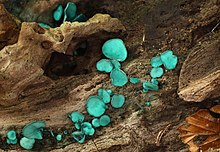Chlorociboria
| Chlorociboria | |
|---|---|

| |
| Chlorociboria sp. | |
| Scientific classification | |
| Kingdom: | |
| Division: | |
| Subdivision: | |
| Class: | |
| Order: | |
| Family: | Chlorociboriaceae Baral & P.R.Johnst. (2015)
|
| Genus: | Chlorociboria |
| Type species | |
| Chlorociboria aeruginosa (Oeder) Seaver ex C.S.Ramamurthi
| |
| Species | |
|
23, see text | |
Chlorociboria is the sole genus of fungi in the family Chlorociboriaceae. The genus includes 23 species.[1]
Two common temperate zone species, Chlorociboria aeruginascens and Chlorociboria aeruginosa, can only reliably be distinguished by microscopic examination. Chlorociboria aeruginosa has larger spores (9–15 µm × 1.5–2.5 µm) and the worm-like cells of the outer surface are rough, unlike the commoner C. aeruginascens, of which the spores are 6–10 µm × 1.5–2 µm.
The hyphae and fruit bodies of all species make xylindein, a secondary metabolite that stains the substrate wood blue-green, with "green oak" being a valued commodity in woodworking. The blue-green pigmented wood is featured in Tunbridge ware.
Habit
Blue-green stain is evident year-round, with ascocarp production occurring from summer to fall.
Species
- Chlorociboria aeruginascens (Nyl.) Kanouse ex C.S.Ramamurthi, Korf & L.R.Batra (1958)
- Chlorociboria aeruginosa (Oeder) Seaver ex C.S.Ramamurthi, Korf & L.R.Batra (1958)
- Chlorociboria albohymenia P.R.Johnst. (2005)
- Chlorociboria argentinensis J.R.Dixon (1975)
- Chlorociboria awakinoana P.R.Johnst. (2005)
- Chlorociboria campbellensis P.R.Johnst. (2005)
- Chlorociboria clavula P.R.Johnst. (2005)
- Chlorociboria colubrosa P.R.Johnst. (2005)
- Chlorociboria duriligna P.R.Johnst. (2005)
- Chlorociboria glauca (Dennis) Baral & Pärtel (2016)
- Chlorociboria halonata P.R.Johnst. (2005)
- Chlorociboria herbicola H.D.Zheng & W.Y.Zhuang (2017)
- Chlorociboria lamellicola Huhtinen & Döbbeler (2010)
- Chlorociboria macrospora P.R.Johnst. (2005)
- Chlorociboria musae Dennis (1959)
- Chlorociboria olivacea Ekanayaka & K.D.Hyde (2019)
- Chlorociboria omnivirens (Berk.) J.R.Dixon (1975)
- Chlorociboria pardalota P.R.Johnst. (2005)
- Chlorociboria poutoensis P.R.Johnst. (2005)
- Chlorociboria procera P.R.Johnst. (2005)
- Chlorociboria salviicolor (Ellis & Everh.) Korf (1979)
- Chlorociboria spathulata P.R.Johnst. (2005)
- Chlorociboria spiralis P.R.Johnst. (2005)
}}
See also
References
- ^ Wijayawardene, Nalin; Hyde, Kevin; Al-Ani, LKT; Dolatabadi, S; Stadler, Marc; Haelewaters, Danny; et al. (2020). "Outline of Fungi and fungus-like taxa". Mycosphere. 11: 1060–1456. doi:10.5943/mycosphere/11/1/8.
External links
- Mushroom Expert Chlorociboria aeruginascens
- Article: "Separation of Chlorociboria aeruginascens and C. aeruginosa" from the Warwickshire Fungus Survey
